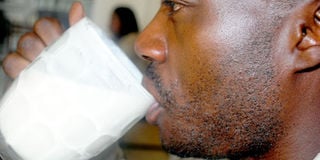Prime
Amakamo, the skin nourishing milk drink

A man enjoys a glass of amakamo. PHOTO BY ALFRED TUMUSHABE
What you need to know:
AMAKOMA. For pastoral communities, there is no limit to dairy products. This drink made from sour milk is a delicacy enjoyed by different people. To taste at its best, find a calabash of the traditionally made one, otherwise a glass made in more modern styles can meet your curiosity.
Erina Karakore’s children are able to get amakoma from the towns they live in, however, they would rather she sent them some litres of this thick milk drink from Mbarara.
“They don’t like the one made using vanilla and sugar. They enjoy mine because I prepare it in the traditional way,” she says.
Amakoma, popular in pastoral communities of Rukungiri, Ntungamo, Mbarara, Kiruhura, Isingiro, Nakasongora, Ntoroko, Ssembabule, Kiboga, Gomba and Luweero districts is best made from raw cow milk although today many prefer to use boiled milk.
How amakamo is made
According to Karakore after milking a cow, milk is sieved to get rid of dirt like cow’s hair and dung that gets in-in the process of milking. It is then boiled and left to cool. It is sieved again sieved again to remove the cream.
The milk is then poured in calabash locally called ekirere. “Ekirere has to be very well cleaned first. It is then treated with a smoke from Omurama tree stem.
That gives a very good aroma. Milk is poured there and Enkamyo is added,” she says.
Enkamyo is for catalyzing the process of milk changing into semi solid form. The traditional ekamyo is the residual milk locally known as amacunda (the milk after ghee has been extracted).
“You put a quarter glass of enkamyo in a 10 litre calabash full of boiled cool milk. The next day (after at least 12 hours) the milk will have turned into amakamo,” she adds.
A drink for women
Before serving, one shakes it so as to break the solidness because it is always thick and therefore not easy to drink.
Traditionally, it is served to family members in milk pots or small calabashes. Families who do not have enough of these for all members serve it in glasses.
“Both men and women drink amakamo. It would also be prepared for a wife during her early days in marriage to make her look healthy and it nourished her skin,” Karakore says.
In the past amakamo was mostly made using unboiled milk because cows were rarely injected or given a lot of drugs and therefore milk was deemed safe.
Nowadays, it has to be boiled because of regular use of drugs in livestock raring. Flora Kambarara, a cattle keeper from Isingiro, says in the past “Men mainly took amashununu (raw milk); women took amakamo while children took amacunda (residual milk-after ghee has been extracted).
Amakamo remains popular in both rural and urban communities. In the latter setting, it is prepared slightly differently and for commercial purposes and served as such.
In towns, it is prepared from jerry cans and metal cans to meet the huge demand there. The materials are never treated with the smoke that adds the aroma and instead of using enkamyo of amacunda, sugar and vanilla are used.
Money maker
“People here prepare milk from jerry cans and other containers but not calabashes. They use vanilla and sugar. But people still enjoy it and dealers are making money from it, its tasty, but the traditional one is far better,” says Wilson Tuwebaze who sells amakamo made in the town style at Western Hotel in Mbarara.
Traders cannot do it the traditional way because it is inconveniencing to use calabashes and then treating the drink with the special smoke. Tumwebaze’s customers are both men and women from pastoral and non pastoral communities.
“Our customers are cattle keepers and non cattle keepers. Everyone is taking amakamo, it is like an energy drink” he says. A glass of 500 ml is sold at Shs 1,000 while a bigger one is sold at Shs 2,000. Kambarara says amakamo is food, which like any other, leaves one satisfied.
She claims that the drink prevents and cures ulcers and gives one a very good skin.




